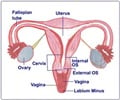Redness in the women's faces changed significantly throughout the month, but peaked at ovulation and remained extra red until after estrogen levels fell.

A constant check on the hormone levels showed that luteinizing hormone was high, indicating ovulation. The largest average difference in redness, however, wasn't a level high enough to be detected by the human eye.
The study involved 22 women. They were photographed daily without makeup using a scientific camera able to capture color more accurately than a typical camera.
A computer program then selected the same patch of cheek from each woman's photo. The images were converted into red, blue and green values to assess changes in color levels.
"Women don't advertise ovulation, but they do seem to leak information about it, as studies have shown they are seen as more attractive by men when ovulating," said Hannah Rowland, Zoology department at University of Cambridge in England.
"We had thought facial skin color might be an outward signal for ovulation, as it is in other primates, but this study shows facial redness is not what men are picking up on -- although it could be a small piece of a much larger puzzle."
Advertisement
"As far back as the 1970s, scientists were speculating that involuntary signals of fertility such as skin color changes might be replaced with voluntary signals, such as clothing and behavior," the study's co-leader, Robert Burriss, a psychologist from Northumbria University in England.
"Some species of primate advertise their fertility through changes in the color of their faces. Even if humans once advertised ovulation in this way, it appears that we don't anymore," he said.
Advertisement
Source-Medindia











